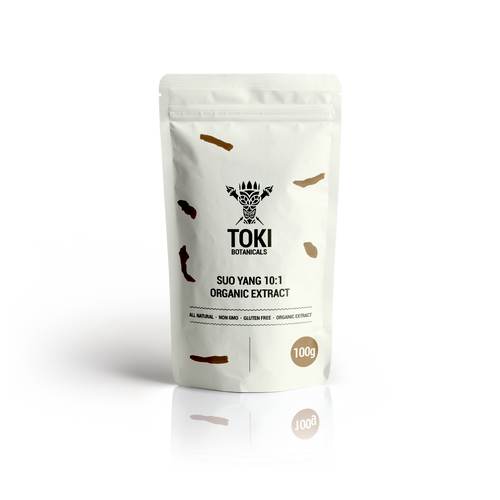Product Description
This is our 10% standardized extract, not as potent as our 60% CO2 extract, but has a wide spectrum of nutrients. Cnidium originally comes from China, and has grown quite a bit because of it's sexual enhancing effects. It is often used within sexual based formulas, but it is quite a multifaceted herb and osthole is a powerful phyto-nutrient. According to research, cnidium has anti-cancer, anti-diabetic, bone building, immune balancing, skin healing, anti-allergenic, anti-microbial, liver-protective, neuro-protective, cardio-protective properties! Many of the effects are due to the effects cnidium has on cAMP, a messenger signal for many biological processes. (1)
The manner in which cnidium works for sexual purposes is multifaceted. Cnidium is helps to inhibit the PDE-5 enzyme, which is something that you don't want much of if you're sexually active. PDE-5 causes erections to soften and deflate, sometimes not in good timing. Inhibiting PDE-5 is like bulletproofing an erection, and also allows men to go multiple rounds without much rest. Several medications like Cialis work through the PDE-5 mechanism, although the effects are stronger, but with side effects as well sometimes. Cnidium also has the effect of relaxing the corpus cavernosa and the muscles surrounding it, allowing more blood flow into that area. Cnidium helps increase nitric oxide levels in the tissues, and allows erections to occur with more ease. Osthole also protects and strengthens the pituitary-adrenocortex axis. (2,3)
Cnidium may also have a bright future for natural cancer treatment, with several studies showing obvious effects. Most of the studies have been done on animals, so more human trials are needed, but the results have been impressive so far. One study concluded that cnidium induced cancer cell death by the de-phosphorylation of Akt. (4,5) Another piece of research showed the effects osthole had on hepatocellular carcinoma by activating mitochondria caspases. (6) Two other studies showed that an extract of cnidium induced apoptosis and cell cycle arrest in human colorectal cancer cells, leukemia, breast cancer cells, and helped prevent the metastasis of lung cancer cells.
Cnidium also shows good potential for those suffering with osteoperosis and osteopenia. The majority of the research has been done in animal models, although one study was done with human cells. Several studies with rats and rabbits are good models though. What the research showed is that some of the nutrients in cnidium inhibited the the resorption and breaking down of bone by inhibiting osteoclastic activity. (7) Osthole actually helped to stimulate several important factors like mRNA expression, p38 mitogen-activated protein kinase (MAPK), and type I collagen. (8) These are two welcomed actions within osteoperosis/penia because the ratio of osteoblastic and clastic activity is usually far from ideal.
In addition the osthole's properties mentioned above, studies have revealed the positive effects it has on multiple organs such as the brain, heart, liver, and may also help those suffering with diabetes, pre-diabetes, and metabolic syndrome. According to some animal research, cnidium lowers lipid levels, increases adiponectin release, activates PPAR activity,improves lipogenic genes, and also improves insulin resistance. (9,10) Animal experiments also saw that it may help to improve memory loss and brain damage. This powerful protective action was due to the antioxidant and anti-inflammatory properties. Osthole and cnidium may also have applications for Parkinson's and Alzheimer's disease, although more research is definitely needed. (11,12) The cardiovascular effects of osthole are due to it's vaso-relaxant, b-oxidative, platelet aggregation inhibiting, anti-inflammatory effects. The multifaceted effects of cnidium and osthole are extremely impressive and would likely help just about anybody. (13)
Suggested use: 400 mgs twice per day, or as needed if only using before sexual activity.
References:
- http://www.ncbi.nlm.nih.gov/pubmed/26246843
- http://www.ncbi.nlm.nih.gov/pubmed/9863099
- http://www.herbalextractsplus.com/cnidium-monnier.html
- http://www.ncbi.nlm.nih.gov/pubmed/27082059
- http://www.ncbi.nlm.nih.gov/pubmed/25859268
- http://www.ncbi.nlm.nih.gov/pubmed/24236568
- http://www.ncbi.nlm.nih.gov/pubmed/22512027
- http://www.ncbi.nlm.nih.gov/pubmed/21734431
- http://www.nature.com/aps/journal/v28/n3/full/aps200751a.html
- https://www.thieme-connect.de/DOI/DOI?10.1055/s-0030-1250268
- http://linkinghub.elsevier.com/retrieve/pii/S0006899311002897
- http://linkinghub.elsevier.com/retrieve/pii/S0006899310020573








